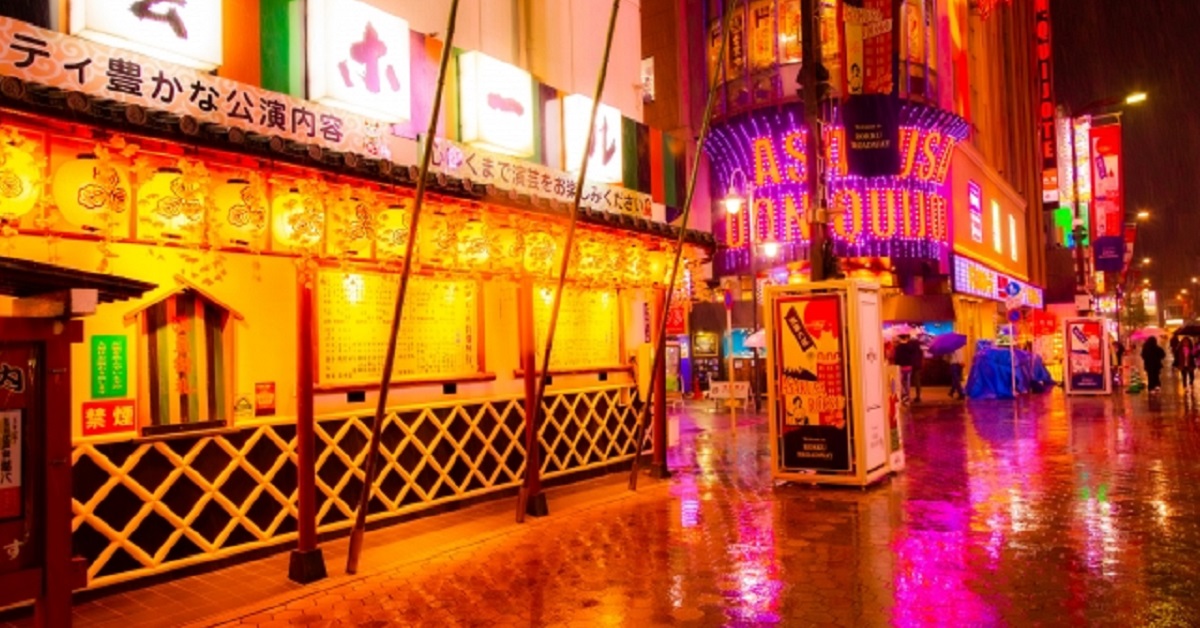Asakusa Rokku still preserves the vibrant atmosphere of the Taisho era and attracts countless visitors as a significant stage of Demon Slayer. It is the backdrop of the first encounter between Tanjiro and Muzan, making it a place where visitors can experience both history and the world of the story.
- The History and Features of Asakusa Rokku
- The Connection Between Demon Slayer and Asakusa Rokku
- Spots Where You Can Experience the Taisho Atmosphere
- Culinary Culture of Asakusa Rokku
- Pilgrimage Routes for Demon Slayer Fans
- Comparing Taisho-era Asakusa and Today
- A One-Day Model Course for Exploring Asakusa Rokku
- How to Fully Appreciate the Charm of Asakusa Rokku
- Conclusion
The History and Features of Asakusa Rokku
Asakusa Rokku began in the late Meiji era when theaters and yose (vaudeville halls) gathered in the area. Later, during the Taisho period, movie theaters and entertainment halls stood side by side, and it developed as the center of popular culture.
At that time, Asakusa was not only home to traditional tourist spots such as Kaminarimon and Nakamise Street but also a place where people experienced the latest entertainment and fashion. It was so lively that it was often called “the heart of Tokyo.” Rokku became the symbolic area of this cultural fusion, known for adopting a blend of Japanese and Western culture earlier than anywhere else.
The Connection Between Demon Slayer and Asakusa Rokku
In Demon Slayer, Asakusa is the place where Tanjiro first encounters Muzan Kibutsuji. The glittering neon lights, the bustling crowds, and the Western-style buildings all reflect the Asakusa of the Taisho period.
The scenery of Rokku in particular overlaps with the depictions in the story, making it a significant sacred place for fans that bridges fiction and reality. Walking through the streets at night evokes the scenes from the anime and manga, creating the sensation of stepping directly into the story itself.
Spots Where You Can Experience the Taisho Atmosphere
Asakusa Rokku still preserves many sights that convey the romance of the Taisho era.
| Highlight | Feature |
|---|---|
| Rokku Broadway | Recreated movie theater street that revives the lively atmosphere of the past |
| Kanban Architecture | Shops with unique Western-style façades popular during the Taisho era |
| Asakusa Entertainment Hall | Still hosts rakugo and comedy shows, boasting more than a hundred years of tradition |
| Neon District | Illuminations recreating the glamour of Taisho modern culture |
Culinary Culture of Asakusa Rokku
Around Rokku, many long-established restaurants continue to serve dishes rooted in Edo and popular during the Taisho era. Tasting them adds both history and flavor to your visit.
| Specialty Dish | Feature |
|---|---|
| Tempura | A specialty since the Edo period, with crispy batter and seasonal seafood |
| Dojo Hotpot (Loach Hotpot) | A working-class dish, conveying the taste of Taisho everyday life |
| Unagi (Eel) | Nutritious and popular as an energy-boosting dish since old times |
| Soba | A staple of downtown Tokyo’s food culture, with historic shops still in business |
Pilgrimage Routes for Demon Slayer Fans
When visiting Asakusa Rokku as a sacred place, walking the streets while recalling the story enhances the experience.
| Pilgrimage Route | Highlight |
|---|---|
| Strolling Rokku at dusk | Neon lights illuminate the streets, recreating the anime’s atmosphere |
| Watching a show at the Entertainment Hall | Experience the same kind of popular culture as in Taisho times |
| Food tour at Nakamise Street | Taste historic sweets and find souvenirs |
| Walking along the Sumida River | Enjoy the same landscape cherished by people a century ago |
Comparing Taisho-era Asakusa and Today
Understanding the differences between Asakusa of the past and present deepens appreciation for Rokku.
| Era | Feature |
|---|---|
| Taisho Period | Neon and Western-style architecture earned it the reputation of being the most modern city in Japan |
| Present Day | Historical buildings are preserved while new tourist facilities are added |
| Common Point | Entertainment and food culture remain central to its identity as a district of the people |
A One-Day Model Course for Exploring Asakusa Rokku
To enjoy Asakusa Rokku to the fullest, a time-structured itinerary is recommended.
| Time of Day | Suggested Activity |
|---|---|
| Morning | Visit Sensō-ji Temple and shop along Nakamise Street |
| Noon | Enjoy tempura or soba at a long-established restaurant nearby |
| Afternoon | Watch rakugo or comedy shows at Asakusa Entertainment Hall |
| Evening | Stroll through Rokku as neon lights start to glow |
| Night | Walk along the Sumida River and relive the Demon Slayer atmosphere |
How to Fully Appreciate the Charm of Asakusa Rokku
When visiting Rokku, it is not enough to just walk down the streets. To truly enjoy it, one must combine history, culture, food, and performing arts. Spend the day exploring Sensō-ji and Nakamise during daylight, then immerse yourself in the neon-lit atmosphere of Rokku at night to feel as if you’ve traveled back in time.
For Demon Slayer fans, this is the only place where you can relive the scene of Tanjiro meeting Muzan, making it a unique destination that deepens your appreciation for the story.
Conclusion
Asakusa Rokku is a rare district that strongly preserves the atmosphere of the Taisho era, while also gaining attention worldwide as a sacred place of Demon Slayer. With entertainment, culinary culture, and historical buildings all in one place, it offers attractions not only for fans but also for general visitors.
For those who visit, there are multiple ways to enjoy—walking in Tanjiro’s footsteps, savoring the romance of the Taisho era, or indulging in local cuisine. Asakusa Rokku is a district that can be appreciated from every angle, continuing to evolve as one of Tokyo’s most symbolic sightseeing areas.






